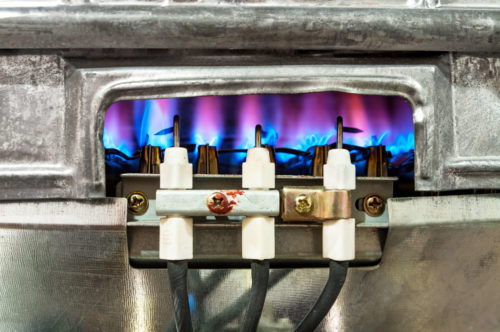Gas burns in modern water heater. Сloseup. Selective focus.

Reality Check: The Myth of Stable and Affordable Natural Gas Prices
This winter, natural gas prices are spiking across the United States and are expected to cause high heating bills throughout the heating season. The US Energy Information Administration (EIA) forecasts that residential gas prices will be 27 percent higher than last winter on average, while electricity prices will only increase by 4 percent. Higher demand as economies reopen through the COVID-19 pandemic, more competition for supply, and producers’ incentives to hold down production have combined to push up commodity prices, with gas futures contracts increasing 91 percent year over year.
Electricity prices, which are driven by the costs of a variety of fuels including renewables, are much less susceptible to individual commodity price shocks.
The gas industry in the United States has a familiar refrain that gas is a reliable and affordable fuel. They go on to claim that as a result, gas-powered heating and electricity generation are essential to energy security and the reliability of the electricity system. In reality, gas prices are historically much more volatile than electricity prices (as shown in the graph below), especially during the winter heating season. This volatility exacerbates household energy burdens when prices spike, particularly for low-income communities, and will threaten the ability of households across the United States to maintain safe, healthy, and comfortable homes this winter.
The EIA forecasts a 27 percent increase in winter residential gas prices, as compared to just a 4 percent increase in electricity prices.
Rapidly increasing gas prices this winter follow an acute price spike in February 2021 that was associated with severe winter storms in Texas and the central United States. Ratepayers are now paying for unforeseen fuel costs borne by utilities resulting from the price increase.
Customers of Oklahoma Natural Gas, for instance, which faced an additional $1.5 billion in costs (or $1,700 per customer) for less than a week’s worth of gas, will now face higher prices to help the utility recover those expenditures. The cost is so high that Oklahoma regulators plan to spread it out over 25 years, requiring customers to spend another $35–$55 each year. Customers who want to switch from gas to electric heat before the 25 years are up would face an “exit fee” from the utility that could be as high as $1,375. Beyond Oklahoma, gas customers across the central United States, from Kansas to Iowa to Minnesota, are seeing rate increase proposals to recover costs associated with last winter—on top of already higher bills for gas heating.
Electric Heat Pumps: A More Affordable Option
With gas prices rising faster than electricity prices this winter, high-efficiency electric heat pumps are becoming a more economically attractive heating option relative to gas furnaces.
Using EIA price forecasts and modeling of winter energy consumption for prototypical single-family homes in several cold-climate cities around the United States, RMI estimated how gas and electricity price increases will differentially impact bills. Our analysis shows that this winter, energy expenditures in homes with high-efficiency, cold-climate electric heat pumps are likely to be lower than in homes with gas furnaces. This economic reality should provide additional impetus for programs and incentives to make heat pump technology affordable and accessible for more American families.
In all five cities RMI analyzed, single-family homes with high-efficiency, cold-climate electric heat pumps are likely to have lower energy expenditures than single-family homes with gas furnaces this winter.
While last winter’s historically low gas prices contributed to lower energy expenditures for homes that heat with gas, prices are unlikely to return to that level for the foreseeable future, according to long-term EIA forecasts.
Low-Income Communities Will Be Hit Harder
Higher gas bills will disproportionately exacerbate energy poverty for low-income communities, as shown in the figure below.
In all five states RMI analyzed, households that can least afford more expensive bills will pay a much greater share of their income toward energy costs this winter due to gas price spikes.
In the states that RMI analyzed, energy expenditures as a percentage of household income are forecast to increase an average of 3 percentage points for the lowest-income households that heat with gas. The highest-income households, in contrast, will see an increase of just 0.3 percentage points. The households that can least afford more expensive bills will pay a disproportionately greater share of their income toward energy costs this winter due to gas price spikes.
Protecting Customers from Price Spikes This Winter and Beyond
Gas and other fossil fuels impose price volatility on the families and businesses that rely on them for heat. And this winter’s gas price spike will raise costs for households across America, highlighting the short-term need to devote more funds to energy assistance programs like the Low Income Home Energy Assistance Program (LIHEAP) and state-level initiatives. Longer term, programs that incentivize adoption of high-efficiency electric heat pumps would address the adverse economic effects of gas price volatility, plus the effects of burning gas on climate change. Policymakers can take these steps to make safe, healthy, and comfortable homes more affordable for everyone—this winter and beyond.


